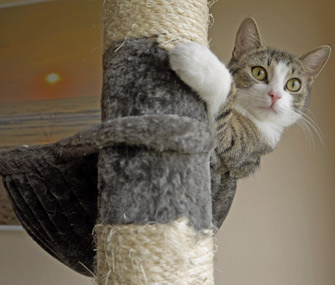Put a Stop to Your Cat’s Clawing and Scratching
Published on February 23, 2016

Are you sick of fuzzy couch legs and ratty carpets? Does your furry friend only occasionally visit scratching posts or avoid them completely? At the same time, your cat’s claws may seem to possess a near magnetic attraction to other surfaces in the home she deems claw-worthy.
As an animal trainer who works with veterinarians and veterinary behaviorists to address problem feline behaviors, I’ve found few other behaviors in the cat that are as misunderstood as scratching. When your cat scratches, your go-to response may be to nix the behavior using punishment. But punishment can create a snowball of problems. Your kitty may feel stressed and anxious from the unpredictability and negative association caused by punitive techniques. She may even withdraw socially or display defensive aggression or inappropriate urination after being punished.
Punishment rarely resolves the scratching. Instead, it may temporarily inhibit the behavior or your cat may choose to scratch out of sight. Frustration can even drive some cat owners to opt for declawing or surrendering the cat. Let’s examine alternatives to strike back at your cat’s problem scratching.
Scratch The Surface
One reason cats scratch is to release energy and explore surfaces. Cats have innate desires to hunt and explore. When they lack better outlets, they may choose scratching and using claws to investigate items within your home and to release pent up mental and physical energy.
Cats of all ages can be serial scratchers. But clawing household items is especially pervasive in young cats or higher energy breeds that possess an overabundance of inquisitive and activity- seeking tendencies. The repetitive motion of scratching is an energy releaser, stress reducer, and may even feel good, as it simulates a yoga-like stretch to the joints. Your curious kitty may also use her claws to reach great heights. As she seeks a bird’s eye view she may cause damage, like scratching your new couch as she scales up the back.
Probably the No. 1 reason cats scratch is for communication. Scratching helps your kitty say to those sharing the space, “I was here.” When she scratches she also leaves behind chemical cues from scent glands in her paws. The smell of their own scent helps cats feel more secure. This is probably why cats that have been declawed continue to scratch. Cats tend to select a few conspicuous places indoors or out and go back to them repeatedly.
Cats may also appreciate the attention they receive for their work. Negative attention is still attention and welcomed by cats craving more human interaction.
Strike Back
Let’s face it — scratching is an innate behavior for cats. So rather than attempting to eliminate clawing, employ a better approach by preventing scratching in undesirable areas and encouraging the behavior in appropriate locations.
Your desire to keep your home and treasured items in good condition is an achievable goal. Best of all, you can redirect clawing to better outlets with non-confrontational techniques your cat will comply with. These steps may also help your cat feel calmer and improve his bond with the people in his life.
First, make designated scratching areas desirable. Where you place scratching posts matters. Location is a large reason some cats won’t use their posts. Is your post in an out-of-the-way room or basement? For your cat, these spaces hold little value for communicating with other animals and people.
Move the scratching posts into areas where your kitty already hangs out and targets for scratching. For example, the living room has high communication value because people and other animals regularly move through these areas. If there are specific objects like a couch your kitty scratches, move the post right in front of his old scratching place.
For multiple cat homes, you may need to add additional scratching posts. Some kitties will not be comfortable in areas patrolled by another cat. Ample scratching posts give opportunities for cats to find a space of their own to claw.
The more scratched up and marked the post, the better for most felines, who seek out their own previous smells and marks. While older scratching posts are less visually attractive to us, these familiar spaces are more attractive for cats.
[object Object]
Attract Your Cat
So what if your cat doesn’t use the assigned scratching area? Maybe it’s the scratching post itself that’s unappealing. Your kitty’s probably tipped her hand about her favorite materials to scratch and her preferred layout. So start by scouting out posts and coverings that mimic her favorite scratching surfaces. These may vary from sisal to cardboard to carpet-covered posts.
Some cats like wood or leather. You can create wood posts or logs or make a leather-covered post. Also, be aware of the post’s layout. Some cats dig vertical surfaces, while others prefer horizontal ones. Or sometimes they enjoy a mix of both. Height also matters. Some cats want to stretch above their heads and pull down. So the base needs to be sturdy to prevent wobbling or a fall when the cat is clawing.
Next, make inappropriately clawed areas unattractive and designated areas more desirable. Place double-sided tape on the surfaces your cat normally scratches — if the adhesive is not going to damage the surface. Making the area sticky to the touch and less enjoyable to scratch will discourage a return visit. Plastic furniture covers and tin foil also make good temporary covering, breaking your cat’s habit while retraining the behavior to other places.
Use scents cats dislike, like citrus-scented air fresheners and sprays, on the areas you want your kitty to avoid. Then offer up desirable designated spaces and reward your kitties for visiting them. These include any cat designated areas, such as cat trees, cat shelving, tunnels and beds, and scratching areas. You may also use chemical attractants, like a synthetic feline facial pheromone (available in some over-the-counter products), and even catnip— for cats who don’t become overly aroused with the substance — on and near scratching posts and cat furniture.
Reward Good Behavior
When your kitty uses the correct areas, offer rewards, including attention, treats, or play with their favorite toys. It may also help to regularly trim your kitty’s claws or cover them with plastic covers. Don’t forget to offer outlets for your cat’s physical and mental energy. Self-play toys, like mechanically activated motion toys, keep active cats entertained even while you’re away or occupied.
Cats also need interactive play with you. Wand toys with feathers and strings are great ways to release a cat’s predatory instinct. Rotate toys regularly and intersperse play sessions throughout the day. Just two to five play sessions lasting two to 10 minutes each day will leave your cat physically and mentally exhausted with less energy for problem scratching. It also keeps your cat’s waistline in check.
It’s also a good idea to create vertical surfaces, such as multiple story cat trees or shelving with grips for the cat to navigate on. Encourage exploration by hiding pieces of their regular meal or treats on the vertical access points or high spaces. Food puzzles made for more stationary licking and those made for active moving with the paws to make meals more like a hunting experience focus your cat on acceptable behaviors.
Finally, if you don’t see a drastic change in your cat’s problem scratching, don’t lose hope. A veterinary behaviorist or positive reinforcement trainer working with your veterinarian can offer solutions for your cat and lifestyle.
Quick tips
- Reward your cat for appropriate marking with small treats the size of a pencil eraser. Think small, soft, smelly, meat-based treats, as these are especially palatable for even the pickiest felines.
- Use food puzzles such as cavity toys that can be stuffed with softer fillings, like canned cat food. Also incorporate active puzzles your cat rolls to release food or those that require paws to fish out kibble.
- Calm your feline by gently touching her cheek area with a towel where scent glands are located and then rubbing this scent over areas your cat frequents. This may help promote the similar feelings of calm and content over space without the need to mark using the glands located by the paws. You may also use a synthetic feline pheromone product that comes in spray and diffuser form and mimics the cheek pheromone used by cats to calm themselves and promotes relaxation in many cats.
- Use feather, wand, mouse, and string toys to add variety to your cat’s play. Some cats prefer the toy to resemble a bird in motion, others a mouse, and even others like a snake. Vary the way the toy moves and allow the cat to get the toy with her claws and teeth at the end of the game. Reward your cat afterwards with a small treat to mimic the end of a successful hunt.
- Consider cat trees and scratching posts with levels. Place these in areas your cat likes to spend time. The goal is to move their preferred areas from unwanted locations, like furniture, to cat designated zones. Reward your kitty with treats, petting, play, and praise when she uses these areas to lie down, venture on, or scratch.
- Practice regular nail trims with your kitten. Cats can learn to enjoy, or at least tolerate, nail trims if you start young. To begin, use lots of rewards and go slowly, trimming just one claw before taking a break. Trim when he’s relaxed and comfortable. Have a helper give rewards, like licks of tuna off a spoon, for remaining calm.
- Use gentle methods to distract your cat from scratching in undesignated areas. If you cat scratches in the wrong area, interrupt gently by moving her to the proper area or luring her with a toy. Then, reward her with attention, praise, play, and treats for scratching in the right area.
- Use a cat-proofed room or crate for your cat when she’s unsupervised to prevent unwanted scratching when she’s left alone.
This article originally appeared in the Fall 2014 issue of HealthyPet magazine.



